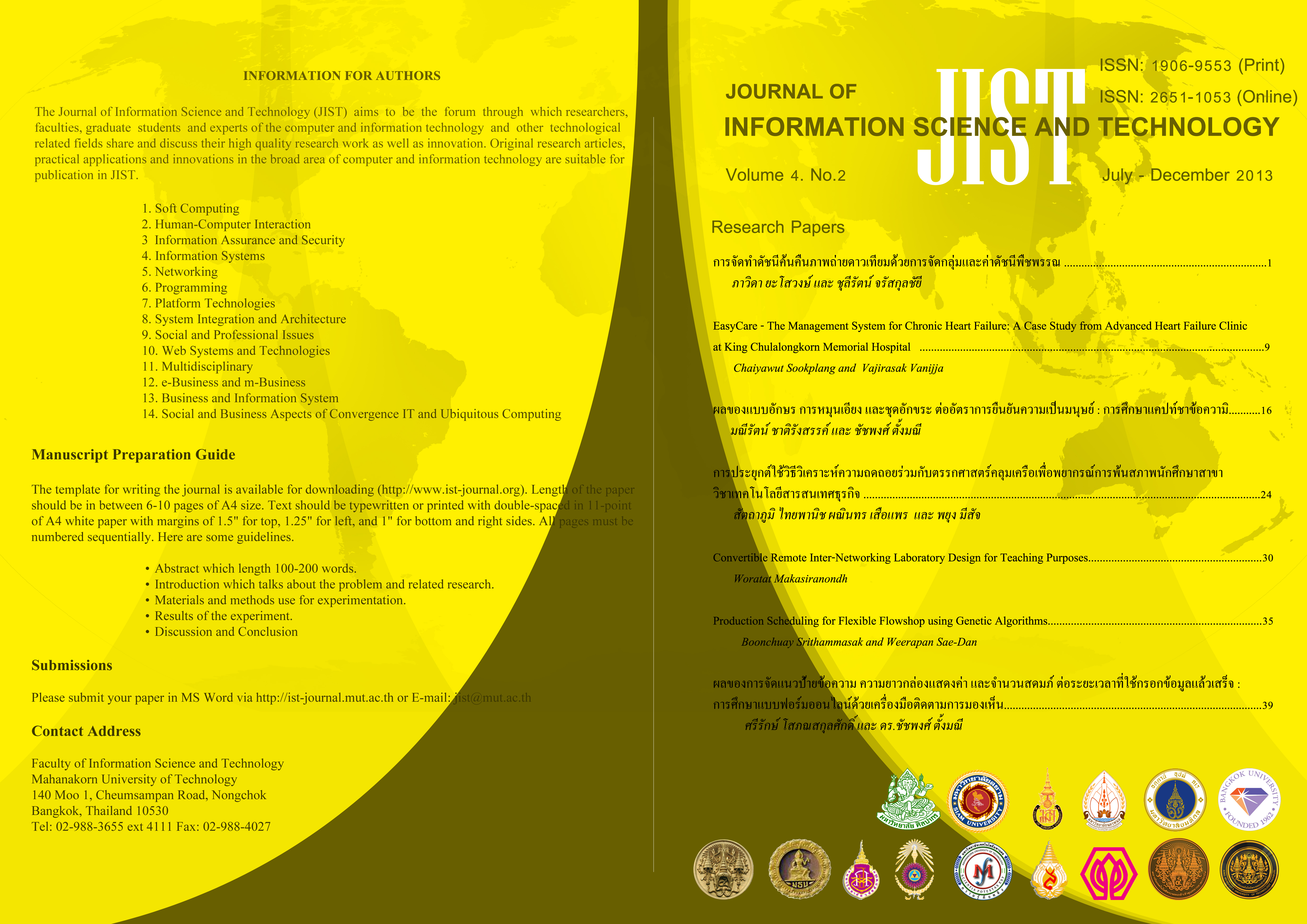Effects of Typefaces, Rotations and Sets of Characters of text-based CAPTCHA on Human Affirmative Rates
Main Article Content
Abstract
- Text-based CAPTCHAs are still a problem for humans. One of the effectiveness indicators for CAPTCHAs, a human-affirmative rate is the proportion of those who are able to correctly decode the text-based CAPTCHAs to those who have made an attempt to do it. It is thus interesting to examine the effects of (1) rotations of characters (2) typefaces and (3) sets of characters of CAPTCHAs on the human affirmative rates. The analysis of a lab experiment indicated that the effect of typefaces and sets of characters of CAPTCHA are statistically significant on the human affirmative rates at the 0.05 level, but the effects of rotations of characters of CAPTCHA were not significant. In addition to extending knowledge of text-based CAPTCHA’s design, developers could apply the findings to select typeface, rotations and sets of characters of text-based CAPTCHA that easy for human.
Article Details
This work is licensed under a Creative Commons Attribution-NonCommercial-NoDerivatives 4.0 International License.
I/we certify that I/we have participated sufficiently in the intellectual content, conception and design of this work or the analysis and interpretation of the data (when applicable), as well as the writing of the manuscript, to take public responsibility for it and have agreed to have my/our name listed as a contributor. I/we believe the manuscript represents valid work. Neither this manuscript nor one with substantially similar content under my/our authorship has been published or is being considered for publication elsewhere, except as described in the covering letter. I/we certify that all the data collected during the study is presented in this manuscript and no data from the study has been or will be published separately. I/we attest that, if requested by the editors, I/we will provide the data/information or will cooperate fully in obtaining and providing the data/information on which the manuscript is based, for examination by the editors or their assignees. Financial interests, direct or indirect, that exist or may be perceived to exist for individual contributors in connection with the content of this paper have been disclosed in the cover letter. Sources of outside support of the project are named in the cover letter.
I/We hereby transfer(s), assign(s), or otherwise convey(s) all copyright ownership, including any and all rights incidental thereto, exclusively to the Journal, in the event that such work is published by the Journal. The Journal shall own the work, including 1) copyright; 2) the right to grant permission to republish the article in whole or in part, with or without fee; 3) the right to produce preprints or reprints and translate into languages other than English for sale or free distribution; and 4) the right to republish the work in a collection of articles in any other mechanical or electronic format.
We give the rights to the corresponding author to make necessary changes as per the request of the journal, do the rest of the correspondence on our behalf and he/she will act as the guarantor for the manuscript on our behalf.
All persons who have made substantial contributions to the work reported in the manuscript, but who are not contributors, are named in the Acknowledgment and have given me/us their written permission to be named. If I/we do not include an Acknowledgment that means I/we have not received substantial contributions from non-contributors and no contributor has been omitted.
References
2. Arditi, A., and Cho, J. “Letter case and text legibility in normal and low vision,” Vision Research 47 (2007): 2499–2505.
3. Chellapilla, K., Larson, K., Simard, P., and Czerwinski, M. “Designing Human Friendly Human Interaction Proofs (HIPs),” Conference on Human factors in computing systems (2005): 711-720.
4. Dafont.com. “Script > School” http://www.dafont.com, 2012
5. Kolupave, A., and Ogijenko, J. “CAPTCHAs: Humans vs bots,” Security and Privacy IEEE (2008): 68-70.
6. Imsamai, M., and Phimoltares, S. “3D CAPTCHA A Next Generation of the CAPTCHA,” Master’s Thesis, Department of Mathematics Faculty of Science Chulalongkorn University, 2010.
7. Quant, L. “Factors Affecting the Legibility of Hand Writing,” Journal of Experimental Education 14 (1964) : 297-376.
8. Rusu, A., and Govindaraju, V. “Handwritten CAPTCHA: Using the difference in the abilities of humans and machines in reading handwritten words,” Proceedings of the 9th Int’l Workshop on Frontiers in Handwriting Recognition (IWFHR-9 2004), IEEE Computer Society, 2004.
9. Rusu, A., and Govindaraju, V. “A Human Interactive Proof Algorithm Using Handwriting Recognition,” Proceedings of the 2005 Eight International Conference on Document Analysis and Recognition (ICDAR’05), IEEE Computer Society, 2005.
10. Shirali-Shahreza, M. H., and Shirali-Shahreza, M. “Multilingual CAPTCHA,” Proceeding of 5th IEEE International Conference on Computational Cybernetics, 2007.
11. Simion, F., Bagnara, S., Bisiacchi, P., Roncato, S., and Umilta, C. “Laterality Effects, Levels of Processing, and Stimulus Properties,” Journal of Experimental Psychology: Human Perception and Performance 6(1) (1980): 184-195.
12. Skype. “Create an account” . https://login.skype.com/account/ signup-form 2012, January 20].
13. Tangmanee, C., and Sujarit - Apirak, P. “Attitude, Cognition, and awareness of Thai internet users and Thai E-commerce entrepreneurs towards CAPTCHA,” Master’s Project, Department of Commerce Faculty of Commerce and Accountancy Chulalongkorn University, 2551.
14. Tinker, M. A. and Paterson, D. G. “Readability of newspaper headlines printed in capitals and lower case,” Journal of Applied Psychology (1946) : 161-168.
15. Tinker, M.A. Legibility of print. Ames, Iowa: Iowa State University Press, 1963
16. Yan, J., and Ahmad, A. S. E. “Usability of CAPTCHAs Or usability issues in CAPTCHA design,” Symposium On Usable Privacy and Security (SOUPS'08), July 23-25, 2008, USA, pp. 44-52.
17. กาธร สถิรกุล. “หนังสือและการพิมพ์”. กรุงเทพฯ : มหาวิทยาลัยรามคาแหง, 2515.
18. กัลยา วาณิชย์บัญชา. “สถิติสาหรับงานวิจัย”. พิมพ์ครั้งที่ 5.กรุงเทพฯ: ธรรมสาร, 2553.
19. ขวัญหทัย สันติบุตร. “ผลกระทบของความล่าช้าของการแสดงผล รูปแบบของเมนู การใช้ข้อมูล ป้อนกลับต่อประสิทธิภาพของการใช้งานบนเว็บแอพพลิเคชั่น”. วิทยานิพนธ์ปริญญามหาบัณฑิต, สาขาการพัฒนาซอฟต์แวร์ด้านธุรกิจ ภาควิชาสถิติ จุฬาลงกรณ์มหาวิทยาลัย, 2549.
20. ศิริวรรณ เสรีรัตน์, สมชาย หิรัญกิตติ, จิรศักดิ์ จิยะจันทน์, ชวลิต ประภวานนท์, ณดา จันทร์สม และ วลัยลักษณ์ อัตธีรวงศ์. “การวิจัยธุรกิจ”. พิมพ์ครั้งที่ 1. กรุงเทพฯ: A.N. การพิมพ์ 304, 2541
21. ศูนย์เทคโนโลยีอิเล็กทรอนิกส์และคอมพิวเตอร์แห่งชาติ. “รายงานผลการสารวจกลุ่มผู้ใช้อินเทอร์เน็ตในประเทศไทย”. สานักงานเลขานุการคณะกรรมการเทคโนโลยีสารสนเทศแห่งชาติ, 2553.


